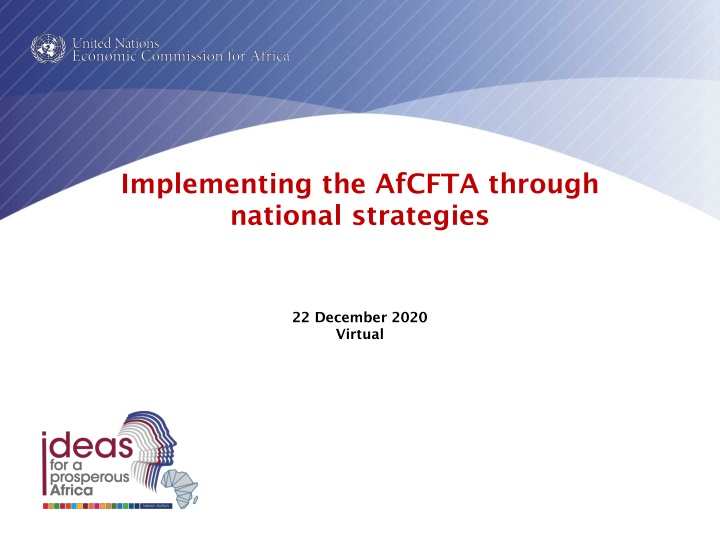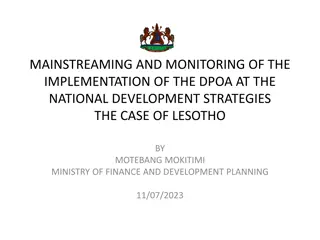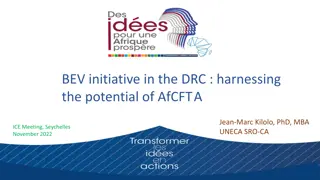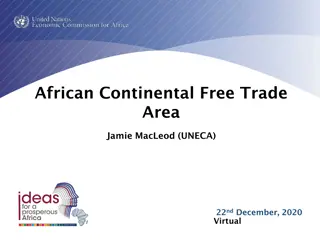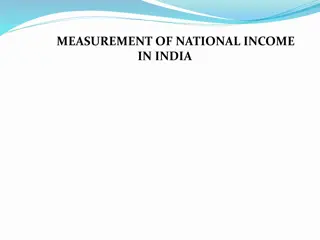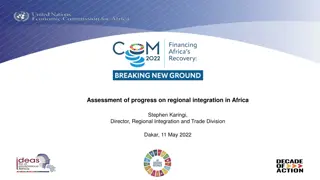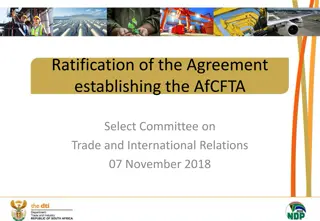Implementing AfCFTA Through National Strategies
The AfCFTA national strategies focus on identifying value addition and trade opportunities, aligning institutional arrangements, and overcoming constraints to enhance trade within Africa. Key components include macroeconomic frameworks, risk mitigation actions, strategic objectives, and communication plans.
Download Presentation

Please find below an Image/Link to download the presentation.
The content on the website is provided AS IS for your information and personal use only. It may not be sold, licensed, or shared on other websites without obtaining consent from the author.If you encounter any issues during the download, it is possible that the publisher has removed the file from their server.
You are allowed to download the files provided on this website for personal or commercial use, subject to the condition that they are used lawfully. All files are the property of their respective owners.
The content on the website is provided AS IS for your information and personal use only. It may not be sold, licensed, or shared on other websites without obtaining consent from the author.
E N D
Presentation Transcript
Implementing the AfCFTA through national strategies 22 December 2020 Virtual _
Outline Contexte and objectives of AfCFTA national strategies Key components of AfCFTA national strategies Communication and visibility plan Approaches required to develop AfCFTA national strategies Status of AfCFTA national strategies
CONTEXT The AfCFTA begins with putting the Agreement into a national/ regional perspective. Countries need to identify capacity gaps to be addressed, as well as their comparative and competitive advantages for diversification and ability to develop or integrate value chains under the Agreement. Optimal institutional arrangements for AfCFTA in support of national level implementation and monitoring efforts while ensuring alignment with regional and continental frameworks. The need to develop AfCFTA-specific national strategies was endorsed by the Conference of African Ministers of Finance, Planning and Economic Development at its fifty-first session, held in Addis Ababa in May 2018, and was reiterated at the 31st Ordinary Session of the Assembly of Heads of State and Government of the African Union, held in Nouakchott in July 2018.
Objectives Facilitating the identification of key value addition and trade opportunities measures including policy interventions and capacities required for it to take full advantage of national, regional and global markets within the context of AfCFTA. Map out actions including those related to institutional arrangements and mechanisms to ensure full coordination implementation and monitoring at national levels while taking into account regional perspectives. Need to be anchored into regional and global policy frameworks, especially those related to trade and inclusive industrial development issues. and constraints, of AfCFTA
Key components of AfCFTA national strategies Macroeconomic Macroeconomic framework, framework, production and production and trade trade AfCFTA AfCFTA- -related risks and mitigation risks and mitigation actions actions related AfCFTA AfCFTA s situational ituational analysis analysis Strategic Strategic objectives, action objectives, action plan, and plan, and monitoring and monitoring and evaluation evaluation framework framework Identification and Identification and prioritization of prioritization of production and production and trade opportunities trade opportunities Constraints to Constraints to overcome and overcome and strategic actions strategic actions required required Cross Cross- -cutting cutting issues issues Financing Financing AfCFTA implementation implementation AfCFTA Communication Communication and visibility plan and visibility plan
Communication and visibility plan Raising awareness and understanding of AfCFTA and leveraging the benefits of the Agreement for stakeholders. Development of communications instruments (e.g., video and audio materials) and the organization of awareness-raising events relating to AfCFTA. Designation of ambassadors to deliver key messages. For example, in the NS of C te d Ivoire, it is suggested to develop a website dedicated to the AfCFTA, easily accessible in different local languages. Most websites of government institutions directly related to trade should dedicate an explicit page to AfCFTA. In the NS of Zimbabwe , it is suggested to create a hotline to respond to AfCFTA related queries as well as to have Hold roundtable/panel discussions on radio and television talk shows for sensitization and engagement on the AfCFTA.
Approaches required to develop AfCFTA national strategies An integrated approach : coherence between the AfCFTA national strategies and other strategies/policies. A participatory approach, through multi-stakeholder consultations, would make it possible to consider not only the interrelationship among different actors, but also to account for their respective needs and interests. Mechanisms for participation must promote the implementation of proactive measures to ensure that women, as a particularly disadvantaged group, are able to make their voices heard.
Status of AfCFTA national strategies Support to 38 countries (including 3 regions, i.e., EAC, ECCAS and ECOWAS). 11 countries have validated their AfCFTA national Strategy. In 2 countries support to implementation has started. Collaboration with AUC and UN agencies : ITC, UNCTAD, UNIDO, IOM.
